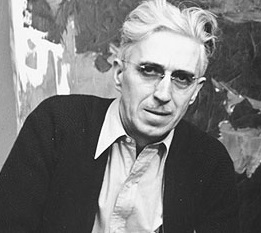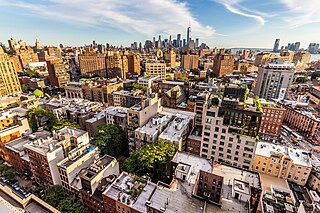Throughout history, forms of art have gone through periodic abrupt changes called artistic revolutions. Movements have come to an end to be replaced by a new movement markedly different in striking ways.

Kurt Vonnegut was an American author known for his satirical and darkly humorous novels. He published 14 novels, three short-story collections, five plays, and five nonfiction works over fifty-plus years; further collections have been published since his death.

Expressionism is a modernist movement, initially in poetry and painting, originating in Northern Europe around the beginning of the 20th century. Its typical trait is to present the world solely from a subjective perspective, distorting it radically for emotional effect in order to evoke moods or ideas. Expressionist artists have sought to express the meaning of emotional experience rather than physical reality.
Abstract expressionism in the United States emerged as a distinct art movement in the immediate aftermath of World War II and gained mainstream acceptance in the 1950s, a shift from the American social realism of the 1930s influenced by the Great Depression and Mexican muralists. The term was first applied to American art in 1946 by the art critic Robert Coates. Key figures in the New York School, which was the center of this movement, included such artists as Arshile Gorky, Jackson Pollock, Franz Kline, Mark Rothko, Norman Lewis, Willem de Kooning, Adolph Gottlieb, Clyfford Still, Robert Motherwell and Theodoros Stamos among others.

Clyfford Still was an American painter, and one of the leading figures in the first generation of Abstract Expressionists, who developed a new, powerful approach to painting in the years immediately following World War II. Still has been credited with laying the groundwork for the movement, as his shift from representational to abstract painting occurred between 1938 and 1942, earlier than his colleagues like Jackson Pollock and Mark Rothko, who continued to paint in figurative-surrealist styles well into the 1940s.

Helen Frankenthaler was an American abstract expressionist painter. She was a major contributor to the history of postwar American painting. Having exhibited her work for over six decades, she spanned several generations of abstract painters while continuing to produce vital and ever-changing new work. Frankenthaler began exhibiting her large-scale abstract expressionist paintings in contemporary museums and galleries in the early 1950s. She was included in the 1964 Post-Painterly Abstraction exhibition curated by Clement Greenberg that introduced a newer generation of abstract painting that came to be known as color field. Born in Manhattan, she was influenced by Greenberg, Hans Hofmann, and Jackson Pollock's paintings. Her work has been the subject of several retrospective exhibitions, including a 1989 retrospective at the Museum of Modern Art in New York City, and been exhibited worldwide since the 1950s. In 2001, she was awarded the National Medal of Arts.

Bluebeard, the Autobiography of Rabo Karabekian (1916–1988) is a 1987 novel by American author Kurt Vonnegut. It is told as a first-person narrative and describes the late years of fictional Abstract Expressionist painter Rabo Karabekian, who first appeared as a minor character in Vonnegut's Breakfast of Champions (1973). Circumstances of the novel bear rough resemblance to the fairy tale of Bluebeard popularized by Charles Perrault. Karabekian mentions this relationship once in the novel.

Breakfast of Champions, or Goodbye Blue Monday is a 1973 novel by the American author Kurt Vonnegut. His seventh novel, it is set predominantly in the fictional town of Midland City, Ohio, and focuses on two characters: Dwayne Hoover, a Midland resident, Pontiac dealer and affluent figure in the city, and Kilgore Trout, a widely published but mostly unknown science fiction author. Breakfast of Champions deals with themes of free will, suicide, and race relations, among others. The novel is full of drawings by the author, substituting descriptive language with depictions requiring no translation.

Color field painting is a style of abstract painting that emerged in New York City during the 1940s and 1950s. It was inspired by European modernism and closely related to abstract expressionism, while many of its notable early proponents were among the pioneering abstract expressionists. Color field is characterized primarily by large fields of flat, solid color spread across or stained into the canvas creating areas of unbroken surface and a flat picture plane. The movement places less emphasis on gesture, brushstrokes and action in favor of an overall consistency of form and process. In color field painting "color is freed from objective context and becomes the subject in itself."

Deadeye Dick is a novel by Kurt Vonnegut originally published in 1982.

The Temptation of Saint Anthony is an often-repeated subject in the history of art and literature, concerning the supernatural temptation reportedly faced by Saint Anthony the Great during his sojourn in the Egyptian desert. Anthony's temptation is first discussed by Athanasius of Alexandria, Anthony's contemporary, and from then became a popular theme in Western culture.

Richard Warren Pousette-Dart was an American abstract expressionist artist most recognized as a founder of the New York School of painting. His artistic output also includes drawing, sculpture, and fine-art photography.

The Cedar Tavern was a bar and restaurant at the eastern edge of Greenwich Village, New York City. In its heyday, known as a gathering place for avant garde writers and artists, it was located at 24 University Place, near 8th Street. It was famous in its day as a hangout of many prominent Abstract Expressionist painters and Beat writers and poets. It closed in April 1963 and reopened three blocks north in 1964, at 82 University Place, between 11th and 12th Streets.

Nat Tate: An American Artist 1928–1960 is a 1998 novel, presented as a biography, by the Scottish writer William Boyd. Nat Tate was an imaginary person, invented by Boyd and created as "an abstract expressionist who destroyed '99%' of his work and leapt to his death from the Staten Island ferry. His body was never found." At the time of the novel's launch, Boyd went some way to encourage the belief that Tate had really existed.

Ben L. Culwell was an American painter and early participant in the abstract expressionist movement. He is most widely known for his participation in the Museum of Modern Art's 1946 Fourteen Americans exhibition. His work is included in the permanent collection of Houston's Menil Collection, the Dallas Museum of Art, the Houston Museum of Fine Arts, as well as the Museum of Modern Art in New York City. In 1977, Culwell's work was featured in a retrospective at the McNay Art Museum. Ten years later in 1987, Culwell's early paintings were featured in Adrenalin Hour, an exhibition given at the opening of the Menil Collection, to critical acclaim. In 2007, his work was included in an exhibition at Baylor University, Texas Modern: The Rediscovery of Early Texas Abstraction 1935–1965.

20th-century Western painting begins with the heritage of late-19th-century painters Vincent van Gogh, Paul Cézanne, Paul Gauguin, Georges Seurat, Henri de Toulouse-Lautrec, and others who were essential for the development of modern art. At the beginning of the 20th century, Henri Matisse and several other young artists including the pre-cubist Georges Braque, André Derain, Raoul Dufy and Maurice de Vlaminck, revolutionized the Paris art world with "wild", multi-colored, expressive landscapes and figure paintings that the critics called Fauvism. Matisse's second version of The Dance signified a key point in his career and in the development of modern painting. It reflected Matisse's incipient fascination with primitive art: the intense warm color of the figures against the cool blue-green background and the rhythmical succession of the dancing nudes convey the feelings of emotional liberation and hedonism.
Alfred Leslie was an American painter and filmmaker. He first achieved success as an Abstract Expressionist painter, but changed course in the early 1960s and became a painter of realistic figurative paintings.

Minimalism describes movements in various forms of art and design, especially Visual art and music, where the work is set out to expose the essence, essentials or identity of a subject through eliminating all non-essential forms, features or concepts. As a specific movement in the arts it is identified with developments in post–World War II Western Art, most strongly with American visual arts in the 1960s and early 1970s. Minimalism is often interpreted as a reaction to abstract expressionism and a bridge to postminimal art practices. Prominent artists associated with this movement include Ad Reinhardt, Nassos Daphnis, Tony Smith, Donald Judd, John McCracken, Agnes Martin, Dan Flavin, Robert Morris, Larry Bell, Anne Truitt, Yves Klein and Frank Stella. Artists themselves have sometimes reacted against the label due to the negative implication of the work being simplistic.

Big Painting No. 6 is a 1965 oil and Magna on canvas painting by Roy Lichtenstein. Measuring 235 cm × 330 cm, it is part of the Brushstrokes series of artworks that includes several paintings and sculptures whose subject is the actions made with a house-painter's brush. It set a record auction price for a painting by a living American artist when it sold for $75,000 in 1970. The painting is in the Kunstsammlung Nordrhein-Westfalen collection.
David Simpson is an American abstract painter and educator, who lives in Berkeley, California. His work is associated with the minimalist, monochrome, and color field movements. Since 1958, Simpson has had more than 70 solo exhibitions of his paintings in galleries and museums worldwide. His paintings have been included in hundreds of group exhibitions throughout the United States and Europe. During the early 1960s Simpson was included in two seminal group exhibitions: Americans 1963 at the Museum of Modern Art in New York curated by Dorothy Canning Miller and Post-Painterly Abstraction curated by Clement Greenberg in 1964; that traveled to the Los Angeles County Museum of Art the Walker Art Center and the Art Gallery of Toronto.
















